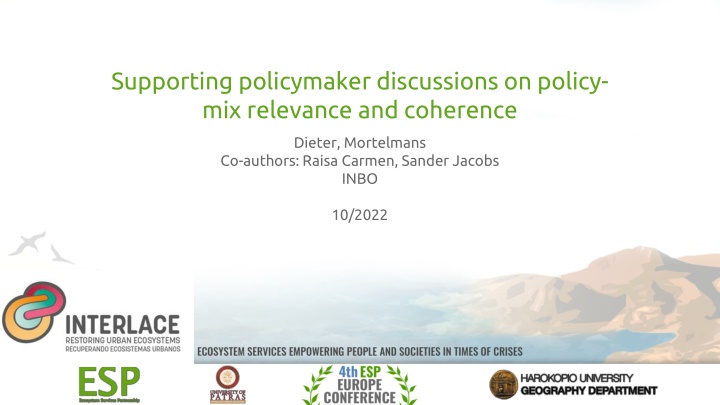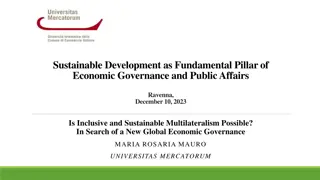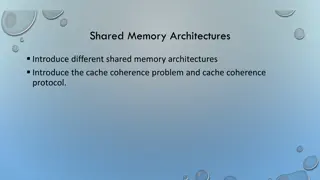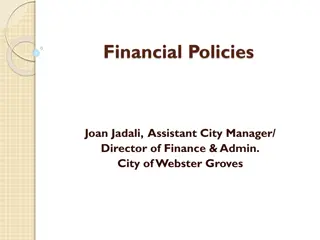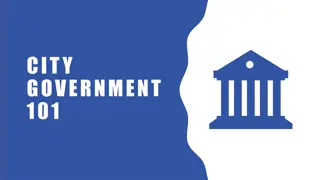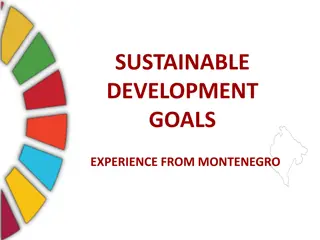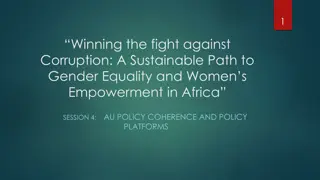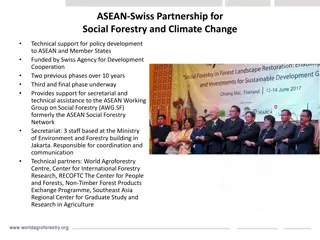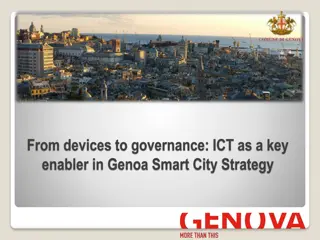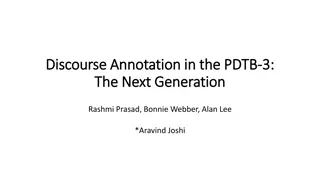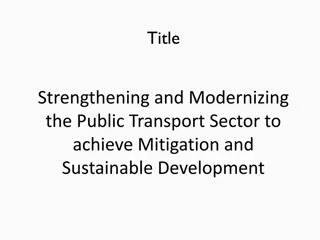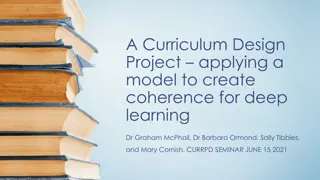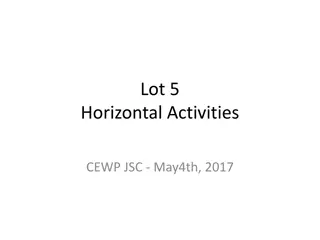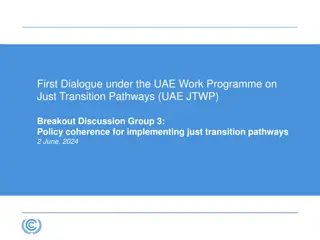Enhancing Policy Coherence for Sustainable City Development
Supporting policymaker discussions on policy relevance and coherence is crucial for addressing high-level societal needs and demands in cities. This involves analyzing the impacts, synergies, and conflicts of policy instruments, ensuring vertical and horizontal coherence, and identifying knowledge gaps for more effective decision-making processes. City objectives such as water reutilization, reducing drought and flood risks, and promoting ecological connectivity play a key role in shaping sustainable urban development.
Download Presentation

Please find below an Image/Link to download the presentation.
The content on the website is provided AS IS for your information and personal use only. It may not be sold, licensed, or shared on other websites without obtaining consent from the author.If you encounter any issues during the download, it is possible that the publisher has removed the file from their server.
You are allowed to download the files provided on this website for personal or commercial use, subject to the condition that they are used lawfully. All files are the property of their respective owners.
The content on the website is provided AS IS for your information and personal use only. It may not be sold, licensed, or shared on other websites without obtaining consent from the author.
E N D
Presentation Transcript
Supporting policymaker discussions on policy- mix relevance and coherence Dieter, Mortelmans Co-authors: Raisa Carmen, Sander Jacobs INBO 10/2022
Impacts? Relevance? Synergies & Conflicts? Granollers, Spain
Cross sectoral, high level societal needs & demands (e.g. climate, biodiversity, ) EU, National strategies & policies Relevance policy instrument mix? VERTICAL COHERENCE Nat. /Reg. Sectoral objectives - Forestry - Agriculture - Tourism - landscape Coherence policy instrument mix? Sectoral policy instruments (= Policy Mix) Local needs & demands (e.g., tourism pressures, larger fields, peace and quiet, ) HORIZONTAL COHERENCE
PolCA (Policy Coherence Analysis) 7 item Likert scale (-3 to +3) 2 matrices: relevance and coherence variability captured by 2 scores per cell Analysis R Script
Knowledge gaps Need for more research? Missing experts? Indication of knowledge spread among experts Need for intersectoral decision making process? Synergies, conflicts between policy instruments Where are discussions/actions needed? Challenge covered by policy instruments Enough policy? Performance policy instrument in regard to objectives Fit with cross sectoral landscape objectives? Disagreements and/or different perceptions of respondents Focus discussions , achieve mutual understanding Design flaws Unintended effects?
City objectives Promote water reutilization Reduce drought risk Reduce flood risk Promote people s reconnection with nature Enhance environmental education Promote ecological connectivity Foster the naturalization of green areas Promote sustainable agriculture Enhance the social and solidarity economy
Policy coherence Granollers, 2021
Policy relevance Krakow Metropolia, 2021
# Content II 14
? 15
KEY LESSONS LEARNT FROM PRACTICE What works well Crystalizing existing knowledge into a common knowledge reference Support the decision-making discussions and process (rather than knowledge compilation) Focus on critical conflicts and potentially (more) readily achievable win-wins What must be considered Find the format that fits the audience (e.g. workshop, report, ) Scientific accuracy may not fit with audience needs: find the appropriate level of accuracy and stick to it! To be continued 16
Strengths Weaknesses Concise overview instead of lengthy report Small dataset as there are only few policy experts with terrain knowledge. The R script allows to partially correct for this. Relies on structuring best available local knowledge on policy impacts and coherence in a quick manner Does not explain underlying reasons of synergies and conflicts, only provides where the problems and opportunities are. The method assumes that local experts are in most cases best able to discuss these reasons. Closely connected to on the ground situation , highly context relevant Results are comparable but cannot readily be upscaled as they are tied to given contexts. Some commonalities can be extracted however. Comparable results over time (quantitative and replicable method) Based on perceived impacts by policymakers and practitioners. Perceptions do not always reflect real impact albeit perceptions are important to consider during decision-making discussions. Co-created by end-users, hence acts as common reference Supports policy discussions rather than directing it Highly flexible and customizable method to match end-user needs 17
